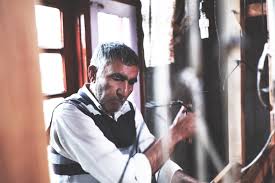
MAKER'S STORIES - GULAM AZEEM
Share
The process to create the forever loved, gentle to the touch Pashmina is not an easy one. In order to produce the raw wool of Pashmina, the ladakhi goat has to grow Pashm, which is possible for the goat only after tolerating a temperature of -50 degrees. The professionals and herders together then comb the wool off the goat’s body. The womenfolk then sort the raw wool with careful attention to every single thread that is below 16 microns in diameter. It is then handspun over a charkha (Yinder) with their bare hands. The threads are barely visible until you really know the art. The threads are later handed over to weavers, who weave them into fabric, mostly manually over a handloom with a little help from the machine. The shawl or scarf that is obtained from the hard work is then sent for embroidery to the artisan who create intricate details of traditional embroidered patterns on the shawls. When it comes to embroidering a Pashmina, it requires years of experience and a great skill to be able to do the job. Let us introduce you one such embroidery artisan, Gulam Azeem Sheikh. Sheikh lost his parents to an accident when he was studying in class 10th, while they were coming back from Jammu, where they went to attend an exhibition, where Sheikh’s father was supposed to display his masterpieces for the people coming from Europe as he was a embroidery artisan himself. Sheikh was then left with a little amount of savings and 3 sisters to take care of. Luckily Sheikh had learnt embroidery from his father and used to help him whenever his father was unwell. He was also gifted with a sense of creativity, as whenever his father would repeat the embroidery motifs on the shawls, he would suggest to create some different ones saying, "Abba, lets embroider it in another way, another pattern", in response the father would laugh as how his little son doesn’t understand the specialty of traditional motifs. Sheikh would then take those ideas and draw the motifs on a paper with ink and save it in a steel trunk. After the death of his father, Sheikh obviously had to leave school and focus on embroidering shawls acquired from the owners of powerlooms. Sheikh understands the importance of shawl craft and so, feels sorrowful while explaining that "Machine made shawls and handmade shawls are two different things, Handmade has a totally different feel.” Sheikh and his friends were employed by the owner of powerloom, who worked on meagre income in a matchbox sized room to hand embroider shawls and scarves for which the owner paid them an amount, which when distributed among the employees, wouldn’t be enough even for a month.
